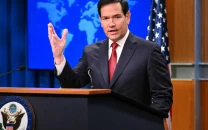A man noted for notes
One almost yearns for a dull moment since the beginning of the end-of-corruption regime

One almost yearns for a dull moment since the beginning of the end-of-corruption regime. After failing to find ways of doubling the revenue and bringing back billions of looted dollars, a former FBR chairman finds the villain of the piece in the 5,000 rupee note. The Indian cash scare — “note bandi that led to economic nas-bandi” — happened not too distant in the past. Mix it with the pains of the current pandemic, and the match will be the instant halt of the economic revival being trumpeted for the past seven months. It is hard to imagine a stupider sense of the way the economy works, especially the one that is the graveyard of the taxmen. While Shamshad Akhtar, the SBP governor at the time off issuance in 2006, should come out to say more, the main reason given at the time was “to provide convenience and facilitate higher value transactions”. High-tech security features was the other important reason. Reduced cost of printing was also mentioned, but not as the main reason cited by the gentleman, much to the laughter of the anchor, an economic philistine. The issue also recognised the need to make it easier for the visually impaired persons to recognise banknotes.
Ten years on, Senator Osman Saifullah Khan, an enlightened businessperson, moved a resolution in the Senate calling for demonetisation of the big note “to reduce illicit money flow, encourage the use of bank accounts and minimise undocumented economy”. It was passed, for good reasons. The government had to oppose due to its timing. The note was issued at a time of high growth of around 6% and demonetisation was opposed at time of lower growth of around 5% to avoid disruption. This precisely is the point. At a time when the economy is struggling to come out of negative terrain, even the talk of demonetisation risks quick reversal. In any case, this is not the route to reduce the role of cash in the economy, as the ratio of currency in circulation to overall money supply is more or less stable. Mercifully, the army of official spokespersons has not jumped into the fray to add this fuel to the anti-corruption fire. Since the provocateur still claims to have the ear of the Prime Minister, a strong contradiction by SBP governor personally is in order. All informal economy is not illegal.
The important question to ask is: Is the 5,000 note really a big note? Suppose in the week ended on January 28, 2021, you went to buy a 20-kg bag of wheat flour, one kg of rice basmati broken (average quality), one kg of rice irri-6/9 (Sindh/Punjab), plain bread (small size), one kg of beef with bone (average quality), one kg of mutton (average quality), one kg of chicken farm broiler (live), one litre of fresh milk (unboiled), one kg of curd (dahi) loose, Nido powdered milk 390 gm poly bag, one dozen hen eggs (farm) and cooking oil like Dalda or a similar brand (2.5 litre), you would have paid a total amount of Rs5,120.9! And this at the national average prices. The range for the flour bag, for instance, is Rs836.6-1,360. These are only 12 out of the 51 items in the Weekly Sensitive Price Indicator. For the same items, you would have paid only Rs1,086.92 in FY2006, the year of introduction of the 5,000 rupees note. It was a big note then, but not anymore. It was too early to issue it in 2006. It is too late to demonetise it in 2021.
Published in The Express Tribune, February 5th, 2021.
Like Opinion & Editorial on Facebook, follow @ETOpEd on Twitter to receive all updates on all our daily pieces.















COMMENTS
Comments are moderated and generally will be posted if they are on-topic and not abusive.
For more information, please see our Comments FAQ